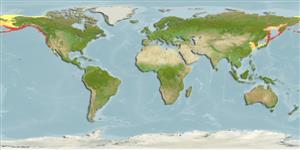分類 / Names
俗名 | 同種異名 | Catalog of Fishes(屬, 種) | ITIS | CoL | WoRMS | Cloffa
Teleostei >
Perciformes/Zoarcoidei (Eelpouts and pricklebacks)
鱸形目 (Eelpouts and pricklebacks) >
Anarhichadidae (Wolffishes)
狼鳚科 (Wolffishes)
Etymology: Anarrhichthys: Greek, anarhichaomai = to climb up + Greek, ichthys = fish; ocellatus: ocellatus for the eye-like spots.
More on author: Ayres.
Environment: milieu / climate zone / depth range / distribution range
生態學
海洋 居於水底的; 深度上下限 1 - 226 m (Ref. 2850). 溫帶; 80°N - 26°N, 117°E - 111°W (Ref. 57366)
North Pacific: Sea of Okhotsk and the Sea of Japan to the Krenitzen Islands, in the Aleutian chain and Imperial Beach, southern California, USA.
北太平洋: 鄂霍次克海與日本海到 Krenitzen 島, 在 Aleutian 鏈與帝王的海灘,美國的南加州。
大小 / 重量 / 年齡
Maturity: Lm ? range ? - ? cm
Max length : 240 cm TL 雄魚/尚未辨別雌雄; (Ref. 4925); 最大體重: 18.4 kg (Ref. 27436)
臀棘: 0; 臀鰭軟條: 200. Dorsal with 228-250 spines. Caudal small. Anal with up to 233 rays.
背部有 228-250根棘。 尾部的小。 臀鰭有向上到 233個鰭條。
Adults seek shelter among rocks in subtidal areas (Ref. 2850) and will occupy the same shelter until driven out by larger wolf-eels or a large octopus (Ref. 28499). Juveniles are pelagic for up to two years (Ref. 28499). Feed on hard-shelled invertebrates and fishes (Ref. 2850). Both male and female wrap their body around the egg mass to keep the eggs in place and to deter predators (Ref. 58332). Large specimens can inflict a painful bite (Ref. 28499). Its flesh is tasty (Ref. 28499).
成魚在亞潮帶區 (參考文獻 2850) 中尋找在岩石之中的庇護所而且將直到被較大的狼鰻或一個大的章魚逐出佔領相同的庇護所。 (參考文獻 28499) 稚魚是大洋性的超過二年。 (參考文獻 28499) 捕食具有硬殼的無脊椎動物與魚類。 (參考文獻 2850) 兩者的雄魚與雌魚卵團的周圍包裝他們的身體適當地保存卵而且制止掠食者。 (參考文獻 58332) 大的標本能施放令人痛苦的咬。 (參考文獻 28499) 它的肉是好吃的。 (參考文獻 28499)
Life cycle and mating behavior
成熟度 | 繁殖 | 產卵場 | 卵 | 孕卵數 | 仔魚
When courting, the male wolf-eel butts his head against the female's abdomen, wraps around her, and fertilizes her eggs as she extrudes them. Eggs are laid and both male and female wrap themselves around the egg mass to protect it . Only one parent at a time leaves the eggs to feed. The female periodically rotates the eggs until they hatch. A male and female may pair for life (Ref. 28499).北太平洋: 鄂霍次克海與日本海到 Krenitzen 島, 在 Aleutian 鏈與帝王的海灘,美國的南加州。
Eschmeyer, W.N., E.S. Herald and H. Hammann, 1983. A field guide to Pacific coast fishes of North America. Boston (MA, USA): Houghton Mifflin Company. xii+336 p. (Ref. 2850)
IUCN 瀕危狀態 (Ref. 130435: Version 2024-2)
無危 (LC) ; Date assessed: 14 December 2020
人類使用
漁業: 低經濟; 水族館: 公眾的水族館
工具
特別的報告
下載 XML
網路資源
Estimates based on models
Preferred temperature (Ref.
123201): 1.2 - 10.5, mean 4.7 °C (based on 485 cells).
Phylogenetic diversity index (Ref.
82804): PD
50 = 1.0312 [Uniqueness, from 0.5 = low to 2.0 = high].
Bayesian length-weight: a=0.00398 (0.00177 - 0.00897), b=3.17 (2.97 - 3.37), in cm total length, based on LWR estimates for this (Sub)family-body shape (Ref.
93245).
營養階層 (Ref.
69278): 3.5 ±0.53 se; based on food items.
回復力 (Ref.
120179): 低的, 最小族群倍增時間4.5 - 14 年 (tm=7; Fec=10,000).
Fishing Vulnerability (Ref.
59153): Very high vulnerability (90 of 100).
Nutrients (Ref.
124155): Calcium = 12.2 [6.7, 26.3] mg/100g; Iron = 0.23 [0.12, 0.46] mg/100g; Protein = 17.9 [15.8, 19.8] %; Omega3 = 0.307 [0.169, 0.537] g/100g; Selenium = 27.5 [14.0, 56.6] μg/100g; VitaminA = 5.19 [1.56, 17.30] μg/100g; Zinc = 0.393 [0.268, 0.590] mg/100g (wet weight);
